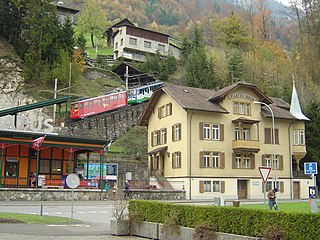
Alpnach is a village in the canton of Obwalden in Switzerland. It comprises the villages of Alpnach Dorf, Alpnachstad and Schoried.

Hergiswil is a municipality in the canton of Nidwalden in Switzerland.

Stansstad is a municipality in the canton of Nidwalden in Switzerland.

Wolfenschiessen is a village and municipality in the canton of Nidwalden in Switzerland. Besides the village of Wolfenschiessen itself, the municipality includes the settlements of Altzellen, Büren ob dem Bach, Dörfli, and Oberrickenbach, together with a large area of high alpine land, mountains, lakes, and glaciers.
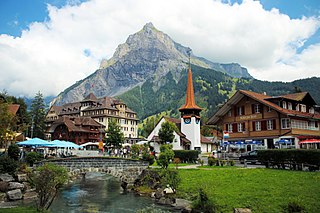
Kandersteg is a municipality in the Frutigen-Niedersimmental administrative district in the canton of Bern in Switzerland. It is located along the valley of the River Kander, west of the Jungfrau massif. It is noted for its spectacular mountain scenery and sylvan alpine landscapes. Tourism is a very significant part of its economic life today. It offers outdoor activities year-round, with hiking trails and mountain climbing as well as downhill and cross-country skiing. Kandersteg hosted the ski jumping and Nordic combined parts of the 2018 Nordic Junior World Ski Championships.

Frutigen is a municipality in the Bernese Oberland in the canton of Bern in Switzerland. It is the capital of the Frutigen-Niedersimmental administrative district.

Brienzwiler is a municipality in the Interlaken-Oberhasli administrative district in the canton of Bern in Switzerland. Besides the village of Brienzwiler, the municipality also includes the settlement of Balmhof.

Schöftland is a municipality in the district of Kulm in the canton of Aargau in Switzerland.

Uitikon is a village and municipality in the district of Dietikon in the canton of Zürich in Switzerland. Besides the village of Uitikon itself, the municipality includes the villages of Waldegg and Ringlikon.
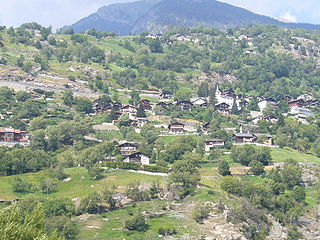
Eggerberg is a village and municipality in the district of Brig in the canton of Valais in Switzerland. Besides the village of Eggerberg, the municipality includes the settlements of Berg, Eggen, Finnen, Mühlackern and Wirmschland.
Lalden is a municipality in the district of Visp in the canton of Valais in Switzerland.

Ausserberg is a municipality in the district of Raron in the canton of Valais in Switzerland.

Blatten is a village and municipality in the Lötschental valley in the canton of Valais in Switzerland. It is part of the district of Westlich Raron, and much of the municipality lies within the Jungfrau-Aletsch protected area, a World Heritage Site. Besides the village of Blatten, the municipality includes the settlements of Eisten, Fafleralp, Ried and Weissenried.

Ferden is a municipality in the district of Raron in the canton of Valais in Switzerland. Besides the village of Ferden itself, the municipality includes the hamlet of Goppenstein, and the alpine settlements of Faldum, Resti and Kummen.
Hohtenn is a village and former municipality in the district of Raron in the canton of Valais in Switzerland. Since 1 January 2009, it has been part of the municipality of Steg-Hohtenn.

Kippel is a municipality in the district of Raron in the canton of Valais in Switzerland.
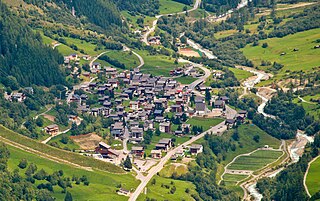
Wiler (Lötschen) is a municipality in the district of Raron in the canton of Valais in Switzerland.

Gampel-Bratsch is a municipality in the district of Leuk in the canton of Valais in Switzerland. It was formed on January 1, 2009. The voters of the municipalities of Gampel and Bratsch decided to merge on January 20, 2008.
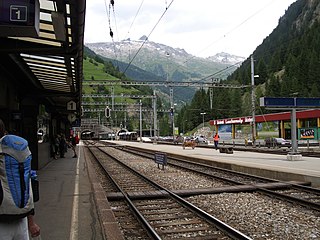
Goppenstein is a railway station in the Swiss canton of Valais and municipality of Ferden. The station is located on the Lötschberg line of the BLS AG, just outside the southern portal of the Lötschberg tunnel. It takes its name from the nearby hamlet of Goppenstein.

Hohtenn is a railway station in the Swiss canton of Valais and municipality of Steg-Hohtenn. The station is located on the Lötschberg line of the BLS AG. It takes its name from the village of Hohtenn that lies just over 1 kilometre (0.62 mi) from, and 253 metres (830 ft) below, the station.






















